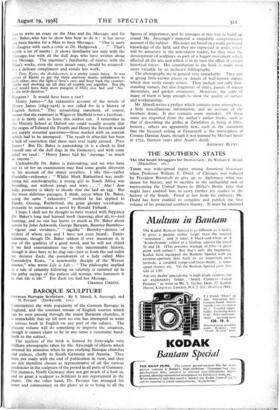BAROQUE SCULPTURE
CONSIDERING the wide popularity of the German Baroque in England, and the constant stream of English tourists which can be seen passing through the major Bavarian churches, it is remarkable that up till now no one has attempted to write a serious book in English on any part of the subject. The present volume will do something to improve the situation, though it cannot claim to be in any sense a systematic hand- book to the subject.
The nucleus of the book is formed by forty-eight very brilliant photographs taken by Mr. Ayscough of objects which arrested his attention when he yeas studying Baroque churches and palaces, chiefly in South Germany and Austria. They were not made with the end of publication in view, and they are not therefore chosen as representative of all the various tendencies in the sculpture of the period in all parts of Germany. For instance, North Germany does not get much of a look in, and so great a sculptor as Schluter is not represented in the Plates. On the other hand, Dr. Pevsner has arranged his notes and commentary on the plates so as to bring in all the
figures of importance, and he manages in this way to build up round Mr. Ayscough's material a singularly comprehensive account of the subject. His notes are based on a really profound knowledge of the field, and they are expressed in terms which will be attractive to the non-expert reader, for they treat the development of sculpture as part of a bigger movement which affected all the arts and which is in its turn the effect of certain historical forces. His contribution to the book is made even more valuable by an inclusive bibliography.
The photographs are in general very remarkable. They aim at giving little-known pieces or details of well-known statues which may easily escape notice. They include not only free- standing statues, but also fragments of altars, panels of stucco decoration, and garden ornaments. Moreover, the scale of many of them is large enough to show the quality of surface and workmanship.
Mr. Sitwell writes a preface which contains some atmosphere, a little miscellaneous information, and an account of the brothers Asam. It also contains some mistakes. Of these some are imported from the author's earlier books, such as that of .describing the grilles at Zwiefalten as being at Otto- beuren ; others are apparently new, such as the statement that the frescoed ceiling at Frauenzell is the masterpiece of Cosmas Damian Asam, though it was painted by Michael Speer in 1752, thirteen years after Asam's death.
ANTHONY BLUNT.






































 Previous page
Previous page